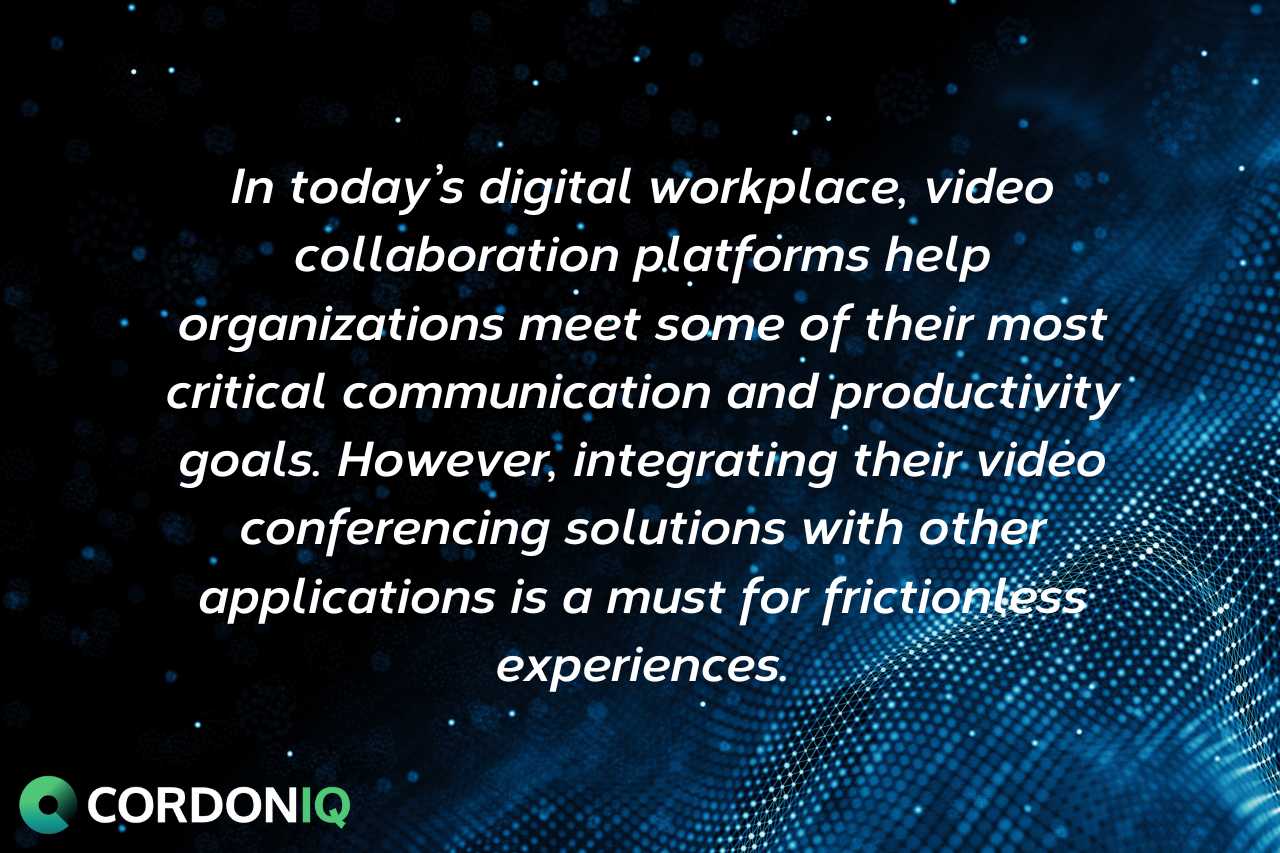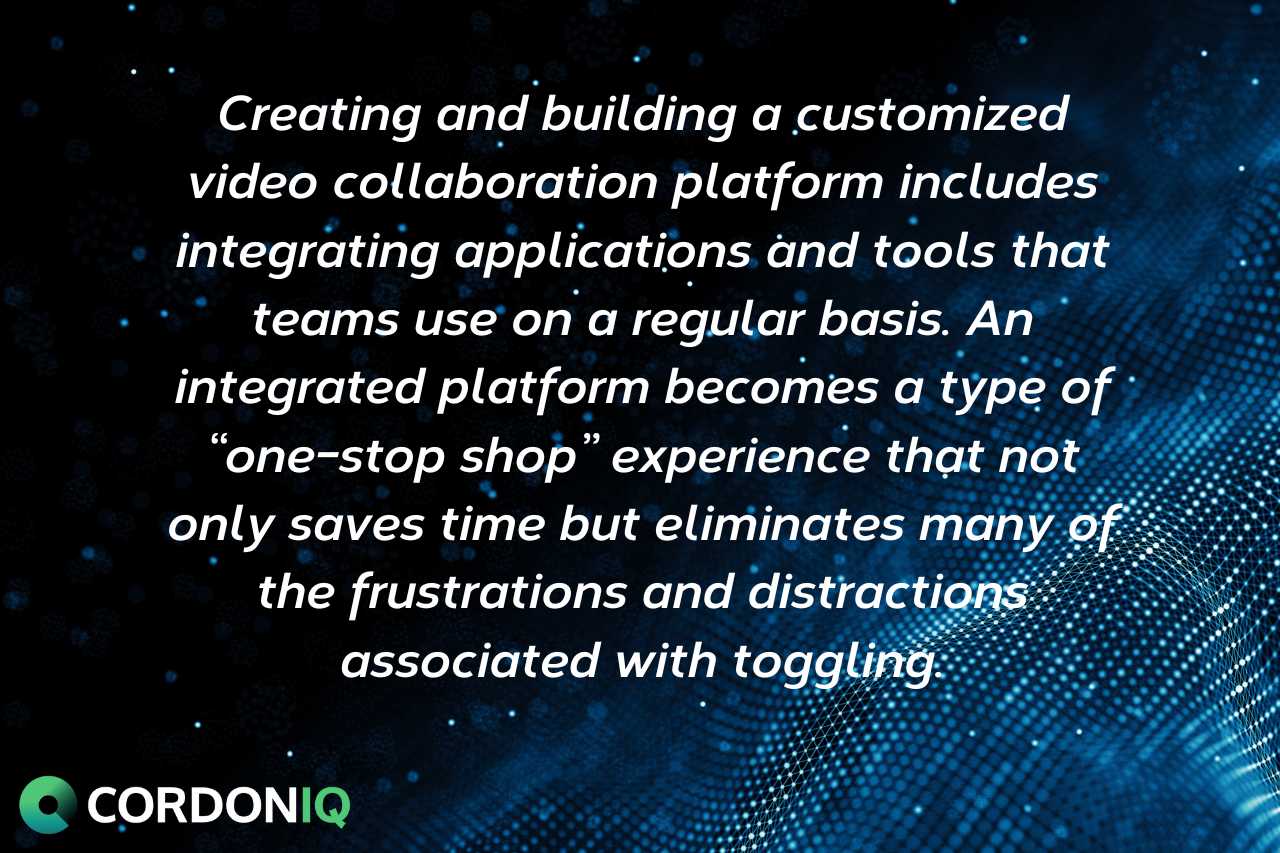Collaboration tools remain a top priority for CIOs as organizations must focus on ways to enhance the employee and client digital experience. According to a report by Forrester, ongoing developments in the digital workplace remain a concern due to factors such as an increase in hybrid work and the economic downturn.
Video conferencing software and related collaboration solutions are among the key components of the digital workplace. It’s imperative for organizations to ensure that their employees have the necessary technology tools to work effectively. Meanwhile, firms need to find ways to build relationships with their clients remotely. Advanced video conferencing and collaboration solutions help enterprises deliver better and more engaging experiences for their employees, teams and clients.

In today’s digital workplace, video collaboration platforms help organizations meet some of their most critical communication and productivity goals. However, integrating their video conferencing solutions with other applications is a must for frictionless experiences. A video conferencing platform API is foundational for optimized integrated video collaboration. Video conferencing platform APIs act as building blocks to incorporate video conferencing and collaboration tools into an organization’s overall tech stack. Developers can use an API-driven video conferencing platform to build customized collaboration solutions.
Let’s take a closer look at the future of collaboration and video conferencing integration, including the benefits of integration and how video conferencing platform integration works.
What is video conferencing software integration?
What is software integration and why is it so critical?
Software integration, or application integration, generally refers to combining software components or modules so that they can work together or enhance one another. Integration allows systems to achieve a smooth transition from application to application. When data and workflows are optimized, IBM notes, “Organizations can achieve integrations that modernize their infrastructures and support agile business operations.”
A couple of decades ago, software integration involved time-consuming and extensive coding. But the adoption of APIs and no-code or low-code tools in recent years has made integration faster and easier.
Software application integration is a key concern for firms and developers looking to accelerate digital transformation to meet the needs of their teams and clients. One significant challenge with integration is the sheer number of applications that organizations use on a regular basis.
Firms are implementing more applications than ever before, and the number has surged since the remote workplace has evolved. According to Mulesoft’s 2023 Connectivity Benchmark Report, “On average, organizations are using 1061 different applications across the enterprise, up from 976 in 2022.” Implementing a multitude of applications often results in data and information silos, with disparate applications that don’t communicate with each other. Data and information silos can frustrate teams and erode productivity.

In order to function optimally, business apps and tools need to be integrated into the organization’s technology infrastructure. Integrated apps that communicate and work together create a smoother experience with less friction. A primary goal of integration is to provide easy and flexible access to critical productivity tools, data and information. An integrated set of solutions is necessary to meet the expectations of today’s teams and clients.
What is video conferencing integration?
Video conferencing integration allows video conferencing and collaboration tools to connect and communicate with other applications within an organization’s overall tech stack. Video conferencing platform APIs are a simple, convenient, flexible and secure way of integrating video collaboration and conferencing tools with other essential business tools.
When video conferencing software is integrated using an API-driven platform, it’s possible for developers to build a customized collaboration system that incorporates a variety of tools depending on the needs of the organization.
What are the benefits of video conferencing integration?
Video conferencing platform integration offers a variety of benefits to enterprises and developers that need to focus on delivering elevated user and client experiences. Some top benefits of implementing integration with a platform solution include the following:
- Flexibility that allows enterprises and developers to build custom collaboration platforms that meet their exact needs and objectives.
- The ability to create and deliver elevated employee and client experiences.
- A time savings because of less need for users to toggle between disparate apps.
- More secure collaboration especially if an API-driven platform is used.
- More streamlined and efficient collaboration with less friction throughout the process.
- Improved and automated workflows.
- Reduced IT costs and better use of resources (eliminates need to build systems from scratch and coding by hand).
- Faster time to development.
How does video conferencing integration work?
How do you integrate video conferencing software with other applications?
API integration is a popular method used to integrate applications and services, including video conferencing and collaboration tools. APIs are used to build the connections and interfaces between an organization’s technology and business tools.

The Platform as a Service (PaaS) model is another effective method to build video conferencing integration with other tools. According to Tech Target, “Platform as a service (PaaS) is a cloud computing model where a third-party provider delivers hardware and software tools to users over the internet.”
PaaS provides a platform that firms can use to develop, run, and manage applications without needing to build and maintain the required cloud infrastructure.
What apps can be integrated with video conferencing software platforms?
With video conferencing integration, especially with an API-driven platform, you have the flexibility to customize a collaboration platform for specific business or industry requirements. For example, industries such as financial services, legal, insurance, management consulting, and banking need specialized applications. Often firms in these industries must meet certain security and privacy requirements because of the confidential and/or sensitive data and information they handle.
An advanced, API-driven video collaboration platform can also enable organizations to create personalized digital experiences for employees based on their role, location, preferences, or other factors. According to Forrester, this personalization is on its way to becoming a “digital workplace requirement,” and includes “the delivery of targeted content, knowledge, apps, and notifications into preferred interfaces.”

Creating and building a customized video collaboration platform includes integrating applications and tools that teams use on a regular basis. An integrated platform becomes a type of “one-stop shop” experience that not only saves time but eliminates many of the frustrations and distractions associated with toggling. This type of solution often increases productivity as a result.
Some top use cases for integrating video conferencing with collaboration tools include the following:
- CRM, sales tools, business management software
- Learning management systems for corporate training
- HR systems – for recruiting and onboarding
- Social media
- Machine learning and AI
- Productivity apps
- Cloud services
- Other workflow and data apps
- Project planning tools
By integrating apps via an API-driven platform for video collaboration, communication and data sharing between apps runs more smoothly.
Cordoniq’s Platform as a Service Model for Video Conferencing Integration
With Cordoniq’s PaaS model, developers can build a custom collaboration platform that integrates with anything in your firm’s or your client’s development stack.
Unlike many generic video meeting services, Cordoniq’s PaaS model is built for enterprise-level solutions. Cordoniq’s purpose-built user experiences incorporate video, voice and live collaboration into an overall solution. Advanced features include UX customization, custom privacy and security features, and assisted roll-out.
Cordoniq provides the toolkit, SDKs, APIs and programming assistance to help deploy a secure custom video conferencing and collaboration solution to private networks or cloud, using containers and incorporating specific requirements. Up to and beyond U.S. military-grade security is a foundation of the platform.
With Cordoniq, access a wide range of APIs that are easy to use and integrate. All API documentation is included. In addition, Cordoniq automatically integrates the following programming languages with our APIs:
- C#
- JavaScript
- Python
- Java
- Typescript
- PHP
- C
- And more
For a complete list of the programming languages, platforms, and tools we integrate with, visit our developer center.